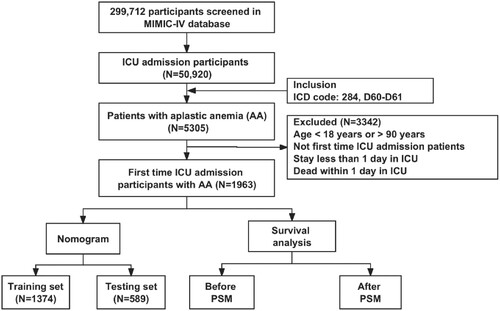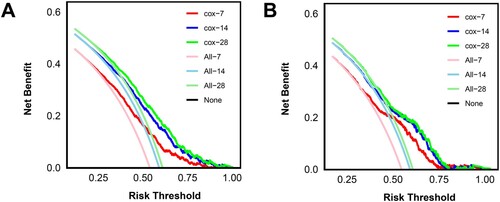ABSTRACT
Objective
To establish an efficient nomogram model to predict short-term survival in ICU patients with aplastic anemia (AA).
Methods
The data of AA patients in the MIMIC-IV database were obtained and randomly assigned to the training set and testing set in a ratio of 7:3. Independent prognosis factors were identified through univariate and multivariate Cox regression analyses. The variance inflation factor was calculated to detect the correlation between variables. A nomogram model was built based on independent prognostic factors and risk scores for factors were generated. Model performance was tested using C-index, receiver operating characteristic (ROC) curve, calibration curve, decision curve analysis (DCA) and Kaplan-Meier curve.
Results
A total of 1,963 AA patients were included. A nomogram model with 7 variables was built, including SAPS II, chronic pulmonary obstructive disease, body temperature, red cell distribution width, saturation of peripheral oxygen, age and mechanical ventilation. The C-indexes in the training set and testing set were 0.642 and 0.643 respectively, indicating certain accuracy of the model. ROC curve showed favorable classification performance of nomogram. The calibration curve reflected that its probabilistic prediction was reliable. DCA revealed good clinical practicability of the model. Moreover, the Kaplan-Meier curve showed that receiving mechanical ventilation could improve the survival status of AA patients in the short term but did not in the later period.
Conclusion
The nomogram model of the short-term survival rate of AA patients was built based on clinical characteristics, and early mechanical ventilation could help improve the short-term survival rate of patients.
1. Introduction
Aplastic anemia (AA) is a rare and fatal bone marrow disease characterized by bone marrow hematopoietic failure and pancytopenia, accompanied by symptoms of bleeding, anemia, and infection [Citation1]. The incidence of AA is 2.35 cases per million people, and the mortality for newly diagnosed AA is as high as 50% and for recurrent AA as high as 70% [Citation2]. For young patients with severe AA (SAA), allogeneic hematopoietic stem cell transplantation (HSCT) can be considered when a human leukocyte antigen (HLA)-matched sibling donor is available [Citation3]. However, less than 30% of people have this condition, especially as family size decreases in East Asia; therefore, most patients require intensive immunosuppressive therapy (IST) with a combination of antithymocyce globulin and cyclosporine [Citation4]. Due to the high degree of AA heterogeneity [Citation5,Citation6], about 1/3 of patients do not respond to IST [Citation7], while SAA patients have a lower response rate to IST [Citation8], which results in SAA prognosis still not ideal [Citation9,Citation10].
Current survival studies on AA are mostly focused on the efficacy of specific treatments for specific populations, such as the development of a mortality prediction scoring system for SAA patients undergoing HSCT [Citation11], and the impact of donor telomere length on the survival rate of AA undergoing HSCT [Citation12]. With the promotion of precision medicine, the formulation of treatment strategies and the personalization of prognosis monitoring are inevitable trends. However, due to the high cost of precision medicine and the lack of large-scale, interpretable, and long-term follow-up population cohorts, the current universal medical model is still irreplaceable. The characteristics of AA and factors for survival in the ICU have not been studied. Therefore, this study used a large-scale MIMIC-IV database to investigate factors of short-term survival by analyzing clinical data related to the death of AA patients in the ICU. It was found that compared with treatments such as renal replacement therapy and red blood cell/platelet transfusion, early mechanical ventilation helped improve the 14-day survival rate of AA patients.
2. Methods
2.1. MIMIC-IV database
The MIMIC-IV database is a publicly available multiparametric critical care database provided by MIT covering patients treated in the ICU at Beth Israel Deaconess Medical Center (BIDMC) from 2008 through 2019. This project was approved by the Institutional Review Boards of MIT and BIDMC and was exempted from the requirement for informed consent. Details are available at https://physionet.org/content/mimiciv/2.2/.
2.2. Patient selection
In the MIMIC-IV database (version 2.2), 5,305 AA cases were confirmed via ICD-9: 284 and ICD-10: D60-D61. Patients who were not admitted to the ICU for the first time had an ICU stay of less than 1 d, died within 1 d of ICU admission, or were aged <18 or >90 years old were excluded. A total of 1,963 patients were finally included in the study and randomly assigned to the training set and the testing set in a 7:3 ratio ().
2.3. Data collection
Demographic data included age, race, and marital status.
Severity scores included Sequential Organ Failure Assessment Score (SOFA), Simplified Acute Physiology Score II (SAPS II) and Glasgow Coma Scale (GCS).
Comorbidities included congestive heart failure (CHF), chronic obstructive pulmonary disease (COPD), acute kidney injury (AKI), kidney disease, multiple myeloma (MM) (ICD-9:2030, ICD-10:C900), and leukemia (ICD-9:2089, ICD-10:C91-C95).
Vital signs included heart rate (HR), mean systolic blood pressure (MBP), respiratory rate, body temperature.
Laboratory indicators included saturation of peripheral oxygen (SpO2), blood glucose concentration, anion gap, bicarbonate concentration, chloride ion concentration, hematocrit, hemoglobin, platelet count, potassium ion concentration, partial thromboplastin time (PTT), international normalized ratio (INR), prothrombin time (PT), sodium ion concentration, blood urea nitrogen (BUN), white blood cell (WBC), red blood cells (RBC), mean corpuscular hemoglobin (MCH), mean corpuscular hemoglobin concentration (MCHC), mean corpuscular volume (MCV), red cell distribution width (RDW), and creatinine levels.
Treatment information included the use of vasopressors (norepinephrine, epinephrine, phenylephrine, dopamine, and vasopressin) for more than 48 h within 24 h of ICU admission [Citation13], mechanical ventilation, use of antibiotics, renal replacement therapy (RRT), and the use of antiplatelet drugs (including aspirin and clopidogrel) during hospitalization [Citation14], platelet transfusion (within the first 14 days of ICU admission), red blood cell transfusion (within the first 14 days of ICU admission) [Citation14].
Outcome included survival time (in days: D), length of stay (LOS), and survival status within 30 days after admission to the ICU. Vital signs and laboratory indicators were collected within 24 h of ICU admission. For indicators with multiple measurements, the most severe measurement was used for data analysis.
2.4. Statistical analysis
Continuous data were expressed as the median and interquartile range (IQR) and compared by the Wilcoxon–Mann–Whitney test, and categorical data were expressed as percentages (%) and compared by the chi-square test. The Univariate Cox regression model was utilized to analyze the training set to obtain potential variables for adverse outcomes. Collinearity between variables was detected by calculating the variance inflation factor (VIF). A VIF value exceeding 4 was considered to have collinearity. Multivariate Cox regression analysis was implemented to determine independent prognosis factors in AA patients and establish the nomogram model to generate risk scores for prognosis factors. C-index and receiver operating characteristic (ROC) curves were utilized to test the discrimination of the nomogram. The calibration curve was generated through 500 bootstrap -resampling, and the Cox regression model was applied to examine its calibration. Decision curve analysis (DCA) was utilized to evaluate the clinical utility of the nomogram. Propensity score matching (PSM) analysis was done using a 1:1 matching ratio, the nearest neighbor matching strategy was selected, and the caliper value was set to 0.2. Survival analysis was done by the Kaplan-Meier curve. Variables with missing values in vital characteristics and laboratory indicators that accounted for more than 20% of the total number of samples were removed to ensure the reliability of the analysis, and the random forest (RF) method was applied to deal with other missing variables. R packages included table one, survival, timeROC, regplot, ggDCA, MatchIt, jskm, rms, and mice.
3. Results
3.1. Baseline characteristics
As listed in , among 1,963 AA patients, the median age was 63.0 years [53.00, 72.00], the majority of patients were white (69.3%), 57.1% were male, and the estimated LOS was 2.6 days [1.70, 4.76], the in-hospital mortality was 57.5%. Regarding treatment, most patients did not use vasopressors (98.1%), mechanical ventilation (86.0%), or renal replacement therapy (95.4%), but most patients used antibiotics (77.8%). In terms of comorbidities, 79.6% of patients had AKI, and there were fewer multiple myeloma (3.2%) and leukemia (4.1%). There were no significant differences in baseline characteristics between the training set (N = 1,374) and the testing set (N = 589) (P > 0.05).
Table 1. Included patients’ characteristics at their initial ICU admission.
3.2. Analysis of factors for survival
As multivariate analysis results presented (), age (HR = 1.02, 95%CI: 1.014-1.027, P < 0.001), SAPS II (HR = 1.015, 95%CI: 1.009-1.02, P < 0.001), RDW (HR = 1.034, 95%CI: 1.007-1.062, P = 0.012), COPD (HR = 1.198, 95%CI: 1.014-1.415, P = 0.034) were independent risk factors for patient survival, body temperature (HR = 0.818, 95% CI: 0.717-1.027, P = 0.003), SpO2 (HR = 0.94, 95%CI: 0.908-0.974, P < 0.001) and mechanical ventilation (HR = 0.619, 95%CI: 00.498-0.769, P < 0.001) were independent protective factors.
3.3. Construction and verification of nomogram
Based on the above results, a nomogram was plotted to predict the 7-day, 14-day and 28-day survival probabilities of patients (). The C-index in the training set and the testing set was 0.642 and 0.643, respectively, indicating that the model had a certain level of accuracy. In both sets, the ROC curve showed favorable prediction performance of the nomogram (). The calibration curve reflected good consistency between its predicted value and the actual value (). The DCA curve showed that the treatment strategy guided by the nomogram had high clinical value ().
Figure 3. Nomogram for predicting 7-, 14-, and 28-day survival probability in participants. Cyan-colored box sizes represent the relative proportion differences among subgroups. The grey density plot of total points illustrates their distribution.
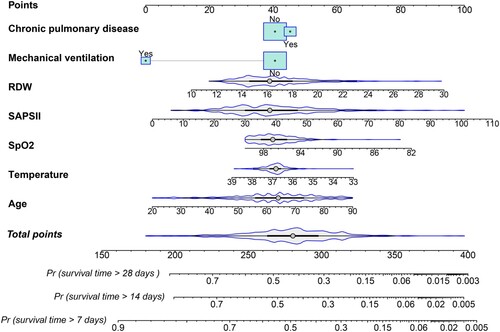
Figure 4. ROC curve analysis for the nomogram in both the training set (A) and testing set (B), with consistent variables included.
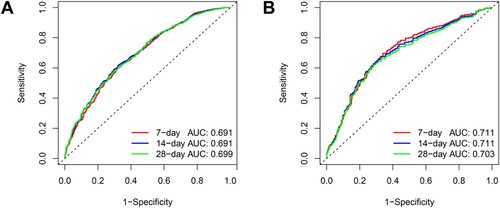
Figure 5. Calibration curves for the nomograms are presented, corresponding to participants in the training set (A) and testing set (B), respectively. The diagonal line signifies an optimal prediction by an ideal model. The red line represents the original cohort, and the green line indicates bias correction achieved through 500 repetitions of bootstrapping.

3.4. Impact of mechanical ventilation on patients’ survival status
(A-B) illustrates Kaplan-Meier curves of AA patients who received mechanical ventilation or not before and after PSM, respectively. The survival status of patients, who received mechanical ventilation, was better than that of patients who did not in the short term. However, the final survival status of the two groups of patients tended to be consistent. Landmark analysis was conducted using 7 days ((C)) and 14 days ((D)) as the critical points. Receiving mechanical ventilation could improve the patient's survival status in the short term but had no significant effect on the patient's later survival status.
Figure 7. Kaplan-Meier survival curves delineate survival probabilities categorized by treatment measures. A and B correspond to Kaplan-Meier curves before and after PSM, respectively. C and D depict Kaplan-Meier curves after PSM with landmark times set at 7 and 14 days for the cohort, respectively.
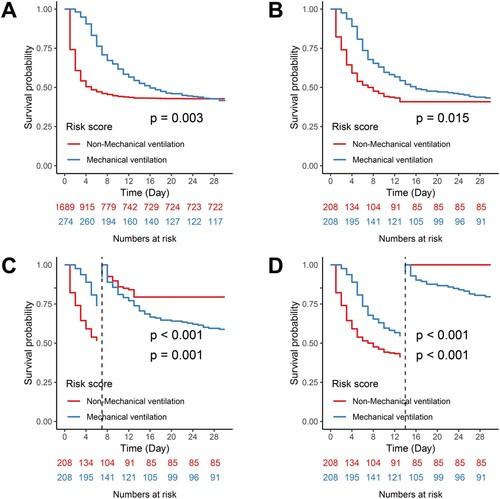
4. Discussion
We established a nomogram, which predicted the survival probability of AA patients within 28 days, including seven predictive factors: SAPS II, COPD, body temperature, RDW, SpO2, age and mechanical ventilation. This is the first large-scale study so far on the prognosis in AA patients, contributing to the identification of subgroups with higher survival risks, thereby enabling more targeted clinical management.
SAPS II, as an indicator to evaluate disease severity, can be used to predict patient prognosis in this work. SAPS II was negatively correlated with prognosis in AA patients. Compared with non-SAA patients, the 5-year overall survival (OS) of patients with SAA and very severe AA (VSAA) is significantly reduced [Citation15]. Therefore, the assessment of disease severity is very important for AA patients admitted to the ICU. Since 1976, the diagnosis of AA severity has been based on the Camitta criteria [Citation16,Citation17]. Yoon HH et al. [Citation18] questioned the Camitta standard in 2012, believing that the parameters in the Camitta standard may need to be modified, and revised it in 2016 [Citation19]. With the advancement of medical treatment, the assessment criteria for AA severity may also require new parameters that keep pace with the times, such as molecular typing, genetic characteristics, etc. [Citation20]. The development of this field is inseparable from the mining of big data and subsequent large-sample, long-term prospective research. It is believed that the nature of AA development can be revealed shortly.
COPD is considered a key factor for the short-term survival of AA patients. COPD is characterized by chronic airway inflammation, leading to the obstruction of airflow in the lungs, leading to muscle atrophy and respiratory failure [Citation21]. After HSCT, patients may develop respiratory failure, which can be related to infectious lung dysfunction and significantly increase the risk of transplant-related death [Citation22]. Moreover, COPD can suppress the response of patients to erythropoietin (EPO) [Citation23], thereby reducing the efficacy of supportive treatment. Our results indicated that mechanical ventilation could significantly enhance the early survival status of AA patients. Mechanical ventilation is a life support system specifically designed to ensure gas exchange [Citation24]. Mechanical ventilation uses mechanical devices to change, control or replace a patient's spontaneous breathing movement through the airway maintenance method of the ventilator. Its main purpose is to optimize ventilation and oxygenation, prevent carbon dioxide retention, improve hypoxia, and fully prepare critically ill patients for treatment [Citation25,Citation26]. The above results reveal that the nature of AA progression may be related to hypoxia. However, earlier studies believed that chronic intermittent hypotension hypoxia is an effective treatment for AA [Citation27]. At high altitudes, hypoxia climate is a protective factor for AA [Citation28], while in benzene-exposed mouse experiments, increased hypoxia levels help maintain the stability of the hematopoietic microenvironment [Citation29]. We speculated that the hypoxia environment may be more about promoting the production of blood cell stimulating factors such as EPO and TPO, thereby improving symptoms of AA patients. The latest research also verifies this. Salidroside inhibits hypoxia in mice but increases TPO expression, so the hematopoietic function of mice is improved [Citation30]. From this point of view, rather than hypoxia, improving the hematopoietic function in the body is an essential treatment method.
Regulation of body temperature is key in maintaining the balance of cellular functions and biological responses. Hypothermia significantly affects the blood regulation mechanism and has adverse effects on platelets, platelet function, fibrinogen, and enzymes in the coagulation cascade. This chain reaction can trigger and aggravate the disorder of the blood system in the patient's physiological balance, thereby adversely affecting the overall physiological state [Citation31]. In recent years, the prognosis value of RDW in hematopoietic and lymphatic system diseases has been validated [Citation32–35]. In patients with advanced chronic lymphocytic leukemia, elevated RDW at diagnosis is associated with shortened OS [Citation34]. In the chronic myelogenous leukemia population, individuals with higher RDW have a significantly lower 5-year OS and progression-free survival than those with lower RDW levels [Citation35]. These findings support our findings; therefore, RDW, as a heterogeneity parameter for red blood cell size, has important clinical value for prognosis prediction in patients with bone marrow hematological diseases. From a pathophysiological perspective, anemia leads to a decrease in hemoglobin concentration and SpO2, resulting in insufficient tissue oxygen supply, inducing cardiomyocyte depletion and myocardial ischemia, which in turn triggers the activation of the reflex mechanism, sympathetic nervous, and angiotensin-aldosterone systems, leading to compensatory increases in HR and blood volume, further aggravating myocardial ischemia [Citation36]. It can also be seen from the factors for short-term survival rate that the treatment of AA fundamentally requires improving hematopoietic function. Other supportive therapies, such as blood component transfusion and protective isolation, can only provide temporary symptomatic treatment, but cannot reach the nature of the disease. But for patients in the ICU, rescue treatment is more about buying time for subsequent radical treatment.
Age is also a pivotal factor. The long-term survival rate of allogeneic bone marrow transplantation in patients over 20 years old exceeds 75% [Citation37]. However, transplant outcomes have historically been poorer in older patients, especially those over 40 years old [Citation37]. It may be related to the increased risk of infection in older patients, lack of optimal conditioning regimen, and higher incidence of graft-versus-host disease [Citation38,Citation39]. Therefore, bone marrow transplantation is considered as first-line treatment for patients under 40 years old when a confirmed HLA-matched family donor is available [Citation3]. IST is recommended as first-line therapy for elderly patients [Citation19]. Treatment modalities should be selected based on patient age, clinical status, and disease severity.
Although the findings are promising, our limitations are apparent. First, the data in the database are retrospective. Although PSM analysis is used to reduce selection bias, considering the long time span, data bias cannot be avoided. Secondly, indicators reflecting hematopoietic function, such as bone marrow pictures, are not available, so we cannot classify the severity of AA. Finally, although the study was internally validated, external validation is needed to make conclusions more comprehensive and reliable.
Author contribution
Yan Tu: Conceptualization, Methodology, Software, Data curation, Writing- Original draft preparation.
Jingcheng Zhang: Conceptualization, Methodology, Investigation, Writing- Original draft preparation.
Mingzhe Zhao: Software, Data curation, Visualization, Writing- Reviewing and Editing.
Fang He: Supervision, Validation, Investigation, Writing- Reviewing and Editing.
Supplementary Tables.docx
Download MS Word (22.1 KB)Supplementary Fig1.docx
Download MS Word (217.4 KB)Disclosure statement
No potential conflict of interest was reported by the author(s).
Data availability statement
The datasets generated and analysed during the current study are available in the [MIMIC-IV] public database.
Reference
- Drexler B, Zurbriggen F, Diesch T, et al. Very long-term follow-up of aplastic anemia treated with immunosuppressive therapy or allogeneic hematopoietic cell transplantation. Ann Hematol. 2020;99(11):2529–2538. doi:10.1007/s00277-020-04271-4
- Vaht K, Goransson M, Carlson K, et al. Incidence and outcome of acquired aplastic anemia: real-world data from patients diagnosed in Sweden from 2000-2011. Haematologica. 2017;102(10):1683–1690. doi:10.3324/haematol.2017.169862
- Bacigalupo A. How I treat acquired aplastic anemia. Blood. 2017;129(11):1428–1436. doi:10.1182/blood-2016-08-693481
- Geng C, Liu X, Chen M, et al. Comparison of frontline treatment with intensive immunosuppression therapy and HLA-haploidentical hematopoietic stem cell transplantation for young patients with severe aplastic anemia - a meta analysis. Leuk Res. 2020;88:106266. doi:10.1016/j.leukres.2019.106266
- Luzzatto L, Risitano AM. Advances in understanding the pathogenesis of acquired aplastic anaemia. Br J Haematol. 2018;182(6):758–776. doi:10.1111/bjh.15443
- Boddu PC, Kadia TM. Updates on the pathophysiology and treatment of aplastic anemia: a comprehensive review. Expert Rev Hematol. 2017;10(5):433–448. doi:10.1080/17474086.2017.1313700
- Yamazaki H, Ohta K, Iida H, et al. Hematologic recovery induced by eltrombopag in Japanese patients with aplastic anemia refractory or intolerant to immunosuppressive therapy. Int J Hematol. 2019;110(2):187–196. doi:10.1007/s12185-019-02683-1
- Scheinberg P. Recent advances and long-term results of medical treatment of acquired aplastic anemia: are patients cured? Hematol Oncol Clin North Am. 2018;32(4):609–618. doi:10.1016/j.hoc.2018.03.003
- Patel BA, Groarke EM, Lotter J, et al. Long-term outcomes in patients with severe aplastic anemia treated with immunosuppression and eltrombopag: a phase 2 study. Blood. 2022;139(1):34–43. doi:10.1182/blood.2021012130
- Tichelli A, de Latour RP, Passweg J, et al. Long-term outcome of a randomized controlled study in patients with newly diagnosed severe aplastic anemia treated with antithymocyte globulin and cyclosporine, with or without granulocyte colony-stimulating factor: a severe aplastic anemia working party trial from the European group of blood and marrow transplantation. Haematologica. 2020;105(5):1223–1231. doi:10.3324/haematol.2019.222562
- Xu LP, Yu Y, Cheng YF, et al. Development and validation of a mortality predicting scoring system for severe aplastic anaemia patients receiving haploidentical allogeneic transplantation. Br J Haematol. 2022;196(3):735–742. doi:10.1111/bjh.17916
- Barade A, Aboobacker F, Korula A, et al. Impact of donor telomere length on survival in patients undergoing matched sibling donor transplantation for aplastic anaemia. Br J Haematol. 2022;196(3):724–734. doi:10.1111/bjh.17880
- Dorken Gallastegi A, Gebran A, Gaitanidis A, et al. Early versus late enteral nutrition in critically ill patients receiving vasopressor support. JPEN J Parenter Enteral Nutr. 2022;46(1):130–140. doi:10.1002/jpen.2266
- Zhou W, Fan C, He S, et al. Impact of platelet transfusion thresholds on outcomes of patients With sepsis: analysis of the MIMIC-IV database. Shock. 2022;57(4):486–493. doi:10.1097/SHK.0000000000001898
- Zhang XT, Wang X, Cao J, et al. Treatment outcome of 301 aplastic anemia patients in China: a 10-year follow-up and real-world data from single institute experience. Hematology. 2021;26(1):1025–1030. doi:10.1080/16078454.2021.2009646
- Camitta BM, Storb R, Thomas ED. Aplastic anemia (first of two parts): pathogenesis, diagnosis, treatment, and prognosis. N Engl J Med. 1982;306(11):645–652. doi:10.1056/NEJM198203183061105
- Camitta BM, Storb R, Thomas ED. Aplastic anemia (second of two parts): pathogenesis, diagnosis, treatment, and prognosis. N Engl J Med. 1982;306(12):712–718. doi:10.1056/NEJM198203253061204
- Yoon HH, Huh SJ, Lee JH, et al. Should we still use Camitta's criteria for severe aplastic anemia? Korean J Hematol. 2012;47(2):126–130. doi:10.5045/kjh.2012.47.2.126
- Killick SB, Bown N, Cavenagh J, et al. Guidelines for the diagnosis and management of adult aplastic anaemia. Br J Haematol. 2016;172(2):187–207. doi:10.1111/bjh.13853
- Dorofeeva AI, Shipunova IN, Luchkin AV, et al. Differences in the differentiation potential and relative levels of gene expression in the bone marrow-derived fibroblast colony-forming units in patients during the onset of aplastic anemia depending on the disease severity. Bull Exp Biol Med. 2023;174(4):538–543. doi:10.1007/s10517-023-05744-y
- Rabe KF, Watz H. Chronic obstructive pulmonary disease. Lancet. 2017;389(10082):1931–1940. doi:10.1016/S0140-6736(17)31222-9
- Haddad IY. Stem cell transplantation and lung dysfunction. Curr Opin Pediatr. 2013;25(3):350–356. doi:10.1097/MOP.0b013e328360c317
- John M, Hoernig S, Doehner W, et al. Anemia and inflammation in COPD. Chest. 2005;127(3):825–829. doi:10.1378/chest.127.3.825
- Kacmarek RM, Villar J, Parrilla D, et al. Neurally adjusted ventilatory assist in acute respiratory failure: a randomized controlled trial. Intensive Care Med. 2020;46(12):2327–2337. doi:10.1007/s00134-020-06181-5.
- Rackley CR. Monitoring during mechanical ventilation. Respir Care. 2020;65(6):832–846. doi:10.4187/respcare.07812
- Rialp G. Mechanical ventilation: past and present. Med Intensiva (Engl Ed). 2021;45(1):1–2. doi:10.1016/j.medin.2020.08.012
- Yang J, Zhang L, Wang H, et al. Protective effects of chronic intermittent hypobaric hypoxia pretreatment against aplastic anemia through improving the adhesiveness and stress of mesenchymal stem cells in rats. Stem Cells Int. 2017;2017:5706193.
- Makeshova AB, Eralieva MO, Levina AA, et al. Particular features of erythropoiesis in high altitude and possibilities of applying of hypoxic hypoxia methodology for the patients with hemopoietic suppression. Voen Med Zh. 2013;334(7):38–45.
- Huang J, Pu Y, Xu K, et al. High expression of HIF-1alpha alleviates benzene-induced hematopoietic toxicity and immunosuppression in mice. Environ Pollut. 2022;311:119928. doi:10.1016/j.envpol.2022.119928
- Liu Z, Chen L, Xiong D, et al. Salidroside affects the Th17/Treg cell balance in aplastic anemia via the STAT3/HIF-1alpha/RORgammat pathway. Redox Rep. 2023;28(1):2225868. doi:10.1080/13510002.2023.2225868
- Wallner B, Schenk B, Hermann M, et al. Hypothermia-associated coagulopathy: a comparison of viscoelastic monitoring, platelet function, and real time live confocal microscopy at low blood temperatures, an in vitro experimental study. Front Physiol. 2020;11:843. doi:10.3389/fphys.2020.00843
- Lee H, Kong SY, Sohn JY, et al. Elevated red blood cell distribution width as a simple prognostic factor in patients with symptomatic multiple myeloma. Biomed Res Int. 2014;2014:145619.
- Perisa V, Zibar L, Sincic-Petricevic J, et al. Red blood cell distribution width as a simple negative prognostic factor in patients with diffuse large B-cell lymphoma: a retrospective study. Croat Med J. 2015;56(4):334–343. doi:10.3325/cmj.2015.56.334
- Podhorecka M, Halicka D, Szymczyk A, et al. Assessment of red blood cell distribution width as a prognostic marker in chronic lymphocytic leukemia. Oncotarget. 2016;7(22):32846–32853. doi:10.18632/oncotarget.9055
- Mao XL, Xi YM, Li ZJ, et al. Higher red blood cell distribution width at diagnose is a simple negative prognostic factor in chronic phase-chronic myeloid leukemia patients treated with tyrosine kinase inhibitors: A retrospective study. Medicine (Baltimore). 2021;100(10):e24003. doi:10.1097/MD.0000000000024003
- Bai Z, Hu S, Wang Y, et al. Development of a machine learning model to predict the risk of late cardiogenic shock in patients with ST-segment elevation myocardial infarction. Ann Transl Med. 2021;9(14):1162. doi:10.21037/atm-21-2905
- Bacigalupo A. Matched and mismatched unrelated donor transplantation: is the outcome the same as for matched sibling donor transplantation? Hematology Am Soc Hematol Educ Program. 2012;2012:223–229. doi:10.1182/asheducation.V2012.1.223.3798305
- Giammarco S, Peffault de Latour R, Sica S, et al. Transplant outcome for patients with acquired aplastic anemia over the age of 40: has the outcome improved? Blood. 2018;131(17):1989–1992. doi:10.1182/blood-2017-09-807859
- Meyers G, Maziarz RT. Is it time for a change? The case for early application of unrelated allo-SCT for severe aplastic anemia. Bone Marrow Transplant. 2010;45(10):1479–1488. doi:10.1038/bmt.2010.134

